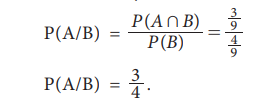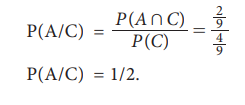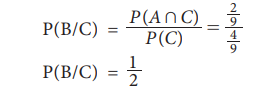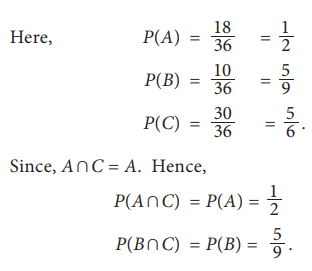Chapter: 11th Statistics : Chapter 8 : Elementary Probability Theory
Conditional Probability
Conditional
Probability
Consider the following situations:
i. two events occur successively or one after the other (e.g) A
occurs after B has occurred and
ii. both event A and
event B occur together.
Example 8.13
There are 4000 people living in a village including 1500 female.
Among the people in the village, the age of 1000 people is above 25 years which
includes 400 female. Suppose a person is chosen and you are told that the
chosen person is a female. What is the probability that her age is above 25
years?
Solution:
Here, the event of interest is selecting a female with age above
25 years. In connection with the occurrence of this event, the following two
events must happen.
A:a person selected is female
B:a person chosen is above 25 years.
Situation1:
We are interested in the event B, given that A has
occurred. This event can be denoted by B|A. It can be read as ŌĆ£B given AŌĆØ. It means that first the event A occurs then under that condition,
B occurs. Here, we want to find the probability for the occurrence of B|A
i.e., P(B|A). This probability is
called conditional probability. In reverse, the probability for selecting a
female given that a person has been selected with age above 25 years is denoted
by P(A|B).
Situation 2:
Suppose that it is interested to select a person who is both
female and with age above 25 years. This event can be denoted by A Ōł®B.
Calculation of probabilities in these situations warrant us to
have another theorem namely Multiplication theorem. It is derived based on the
definition of conditional probability.

Definition of Conditional of Probability
If P(B) > 0, the conditional probability
of A given B is defined as

If P(B) = 0, then P(AŌł®B) = 0. Hence, the above formula is
meaningless when P(B) = 0. Therefore, the conditional probability P(A|B) can be
calculated only when P(B)>0.
The need for the computation of conditional probability is
described in the following illustration.
Illustration
A family is selected at random from the set of all families in a
town with one twin pair. The sample space is
S = {(boy, boy), (boy, girl), (girl, boy), (girl, girl)}.
Define the events
A: the randomly
selected family has two boys, and
B: the randomly selected
family has a boy.
Let us assume that all the families with one twin pair are
equally likely. Since
A = {(boy, boy)},
B = {(boy, boy), (boy, girl), (girl, boy)},
AŌł®B = A = {(boy, boy)}.
Applying the classical definition of probability, it can be
calculated that

Suppose that the randomly selected family has a boy. Then, the
probability that the other child in the pair is a girl can be calculated using
conditional probability as

Example 8.14
A number is selected randomly from the digits11 through 19.
Consider the events
A = { 11,14, 16, 18, 19
}
B = { 12, 14, 18, 19 }
C = { 13, 15, 18, 19 }.
Find (i) P(A/B) (ii) P(A/C) (iii) P(B/C) (iv) P (B/A)
Solution:

Therefore, the probability for the occurrence of A given that B
has occurred is

The probability for the occurrence of A given that C has
occurred is

Similarly, the conditional probability of B given C is

and the conditional probability of B given A is

Example 8.15
A pair of dice is rolled and the faces are noted. Let
A: sum of the faces is
odd, B: sum of the faces exceeds 8,
and
C: the faces are
different then find (i) P (A/C) (ii) P (B/C)
Solution:
The outcomes favourable to the occurrence of these events are
A = { (1,2), (1,4), (1,6), (2,1), (2,3), (2,5), (3,2), (3,4),
(3,6), (4,1), (4,3), (4,5), (5,2), (5,4), (5,6), (6,1), (6,3), (6,5) }
B = { (3,6), (4,5),
(4,6), (5,4), (5,5), (5,6), (6,3), (6,4), (6,5), (6,6) }
C = { (1,2), (1,3),
(1,4), (1,5), (1,6), (2,1), (2,3), (2,4), (2,5), (2,6), (3,1), (3,2), (3,4),
(3,5), (3,6), (4,1), (4,2), (4,3), (4,5), (4,6), (5,1), (5,2), (5,3), (5,4), (5,6), (6,1),
(6,2), (6,3), (6,4), (6,5) }
Since A and B are proper
subsets of C, AŌł®C = A and BŌł®C = B.

Hence,
the probability for the sum of the faces is an odd number given that the faces
are different is

Similarly,
the probability for the sum of the faces exceeds 8 given that the faces are
different is

Axioms
The
conditional probabilities also satisfy the same axioms introduced in Section
8.3.
If
S is the sample space of a random experiment and B is an
event in the experiment, then
(i)
P(A/B) Ōēź 0 for any event A of S.
(ii)
P(S/B) = 1
(iii)
If A1, A2, ŌĆ” is a sequence of mutually exclusive events,
then

In
continuation of conditional probability, another property of events, viz.,
independence can be studied. It is discussed in the next section. Also,
multiplication theorem, a consequence of conditional probability, will be
studied later.
Related Topics